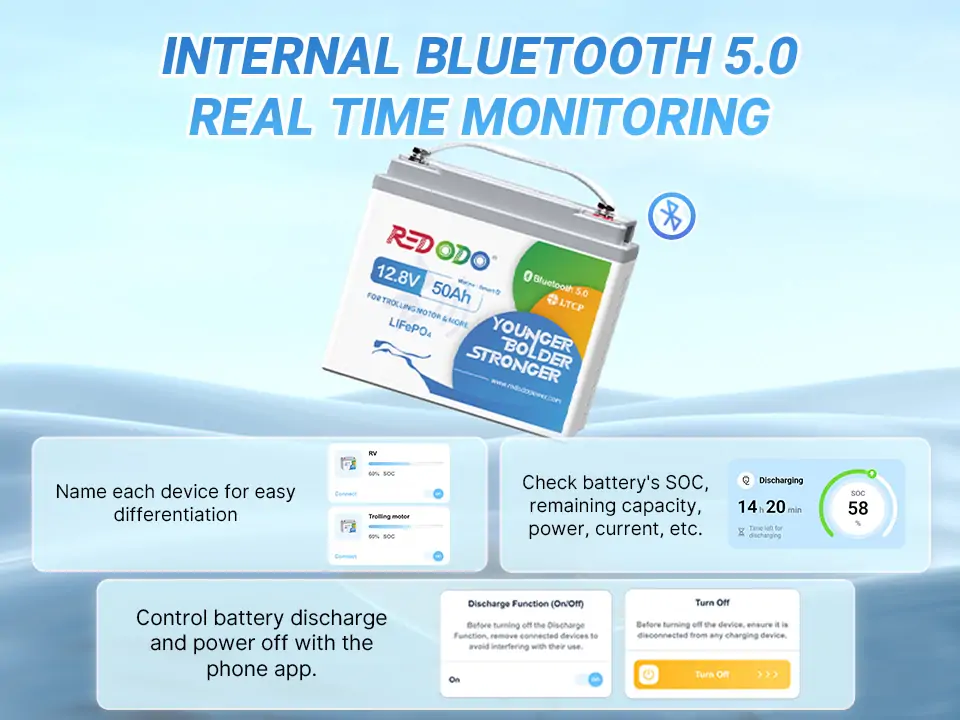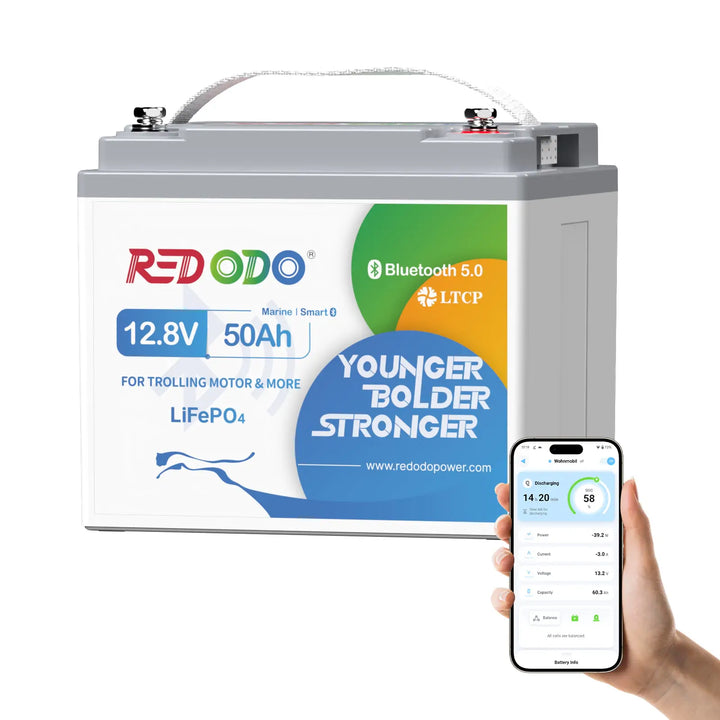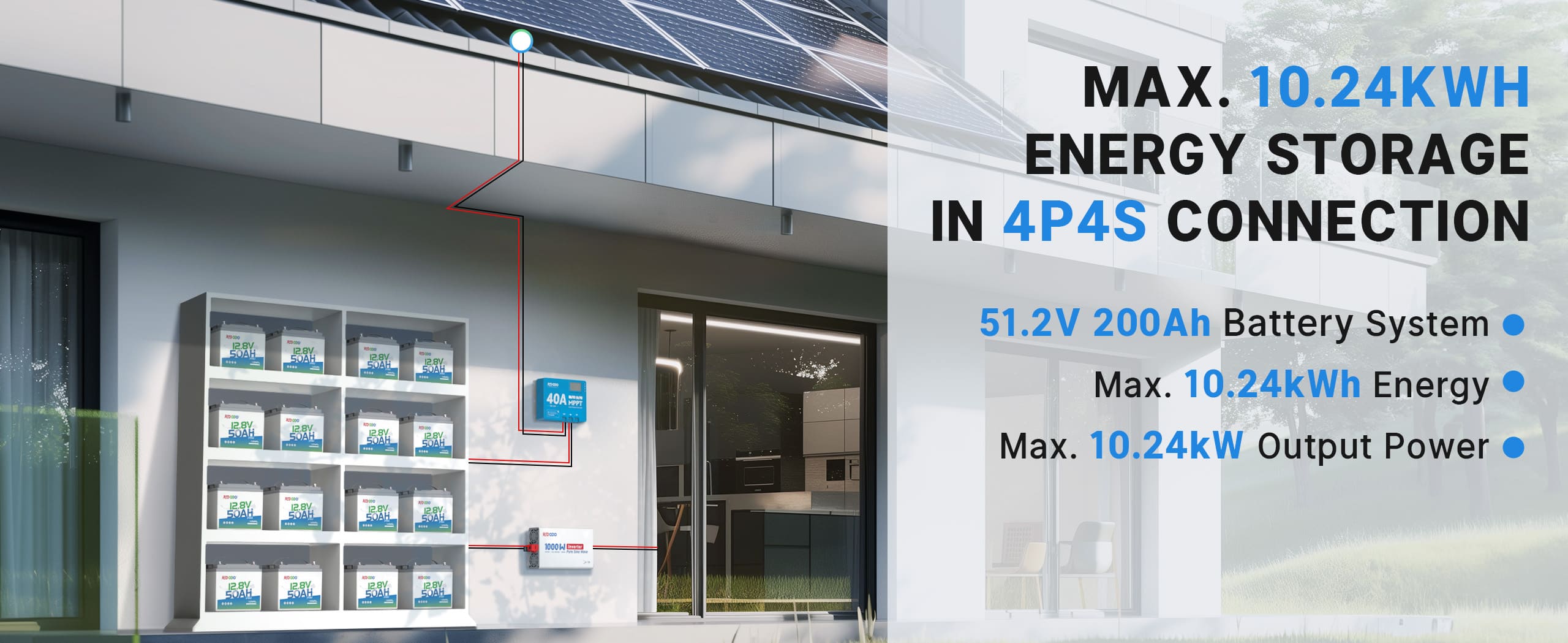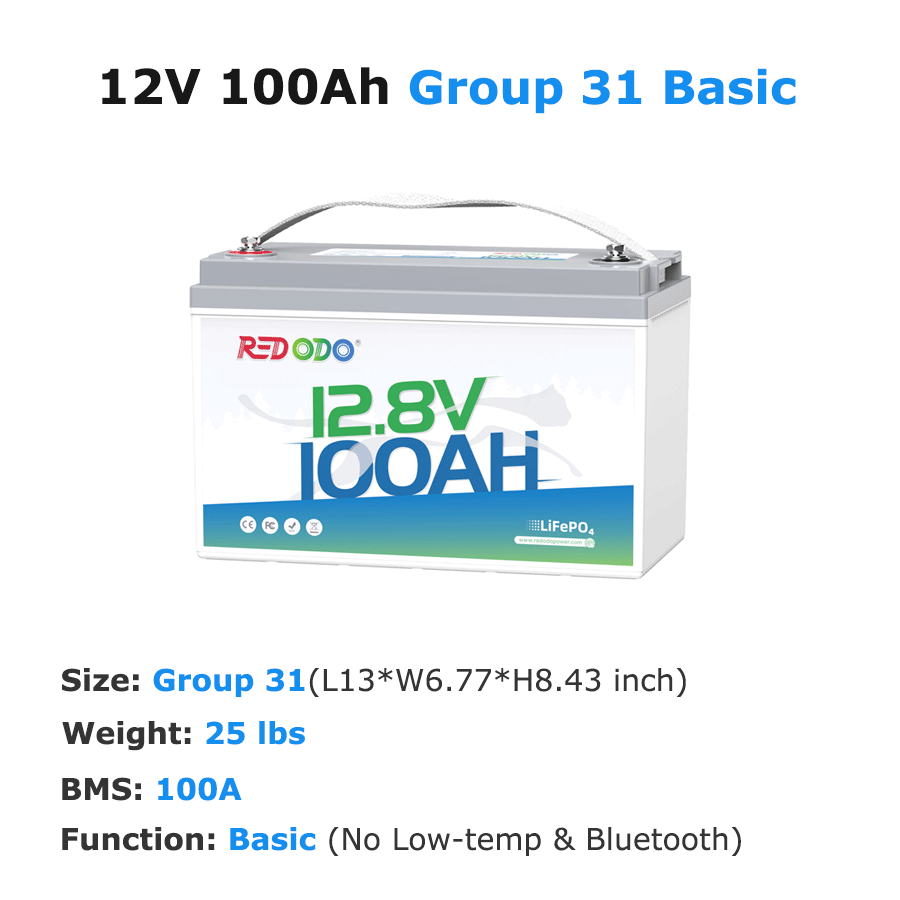Is A 50Ah Lithium Battery Better than A 100Ah Lead-acid Battery?
When choosing a battery for your RV, boat, solar system, or backup power application, capacity ratings of different battery types can be misleading. A common question is: A 50Ah lithium battery vs. 100Ah lead-acid battery, which is better? The answer is the 50Ah lithium.
In this article, we’ll compare these two popular battery types and explain why a smaller lithium battery often outperforms its larger lead-acid counterpart.
Key Takeaway: 50Ah Lithium vs. 100Ah Lead-Acid Battery
| Aspect | 100Ah Lead-Acid Battery | 50Ah LiFePO4 Lithium Battery |
|---|---|---|
| Usable Capacity | ~50Ah (limited to 50% DOD at 1C) | ~50Ah (usable up to 100% DOD) |
| Weight | Heavy (~60–70 lbs) | Lightweight (~11–13 lbs) |
| Size | Bulky | Compact |
| Lifespan | 200–500 cycles (2–3 years) | 4,000–15,000+ cycles (10+ years) |
| Charging Time | 7–12 hours | 2–5 hours |
| Voltage Stability | Drops rapidly during discharge | Steady throughout discharge |
| Maintenance | Needs regular maintenance | Maintenance-free |
| Temperature Tolerance | More capacity loss | Less capacity loss |
| Environmental Impact | Contains lead & acid (toxic) | Non-toxic and recyclable |
| Upfront Cost | Lower | Higher upfront, lower cost per cycle |
| Overall Value | Lower efficiency, shorter life | Long-term performance & savings |
Understanding Battery Capacity: 50Ah vs. 100Ah
Amp-hours (Ah) measure a battery’s storage capacity, indicating how long the battery can last at a certain amp current. On paper:
- A 50Ah lithium battery can deliver 50 amps for 1 hour.
- A 100Ah lead-acid battery can deliver 100 amps for 1 hour.
However, due to the battery chemistry, a lead-acid battery can only safely use about 50% of its rated capacity at high discharge rates (like 1C), while a lithium battery can reach 100% usable capacity. That means a 100Ah lead-acid battery may offer similar or even less usable energy than a 50Ah lithium battery.
| Battery Type | Rated Capacity | Usable Capacity | DOD Limit |
|---|---|---|---|
| 50Ah Lithium (LiFePO4) | 50Ah | 50Ah (100%) | Up to 100% |
| 100Ah Lead-acid (AGM) | 100Ah | ~50Ah (50%) | ~50% |
.jpg)
Performance Comparison: Lithium vs. Lead-Acid
When choosing between a 50Ah lithium battery and a 100Ah lead-acid AGM battery, the actual performance matters more than numbers on a label. Here's a breakdown of how they compare in various categories:
1. Weight and Size
One of the most noticeable differences is weight. Lead-acid batteries are significantly heavier, which makes them harder to transport and install, especially in RVs, boats, and other mobile applications.
For instance, a typical 100Ah lead-acid battery weighs between 60 to 70 lbs, while a 50Ah LiFePO4 lithium battery generally weighs around 11 to 15 lbs. That’s over 75% lighter, making lithium batteries a far better option for weight-sensitive applications.
- 50Ah lithium battery: ~11-13 lbs (5-6 kg)
- 100Ah lead-acid battery: ~60-70 lbs (27-32 kg)
2. Lifespan and Cycle Count
Lead-acid batteries generally last 200–500 cycles, depending on usage, temperature, and maintenance. That translates to about 2–3 years of service life under regular use.
LiFePO4 lithium batteries like Redodo typically last 4,000 to 15,000+ cycles, or over 10 years with proper care. Over a 10-year span, you might replace a lead-acid battery 3–4 times, while a lithium battery just keeps going.
- Lithium (LiFePO4): 4,000–15,000+ cycles
- Lead-acid: 200–500 cycles
A 50Ah lithium battery can last 3 times longer than a lead-acid battery with proper use. The long lifespan makes them ideal for daily or deep-cycle applications like marine deep cycle, solar storage, trolling motors, and RV systems.
3. Usable Capacity
Lead-acid batteries are only 50% usable in 1C high discharge rate due to their recommended depth of discharge (DOD). This means a 100Ah lead-acid battery delivers only about 50Ah of usable power.
By contrast, a 50Ah lithium battery can offer about 50Ah of usable energy because it supports up to 100% DOD without compromising performance. So, you’d need two 100Ah lead-acid batteries to match the usable capacity of one 50Ah lithium battery over time.
- Lithium (LiFePO4): 100% usable capacity (at 100% DOD)
- Lead-acid: 50% usable capacity (at 50% DOD)
4. Charging Speed
A lead-acid battery may take 7–12 hours to fully recharge due to slower absorption phases. On the other hand, lithium batteries accept higher charge currents, making them charge much faster in about 2–5 hours, depending on the charger and setup.
This faster turnaround time is a big advantage for users who need to get back on the road, water, or trail quickly.
- Lithium: can be fully charged in 2-5 hours (Some can fast charge in 1 hour)
- Lead-acid: can be fully charged in 6-12 hours
5. Low-Temperature Performance
Cold temperatures can impact battery performance. The lead-acid’s chemical reactions could slow down in freezing temperatures, leading to usable capacity loss.
Lithium batteries, especially premium LiFePO4 models, have less capacity loss. Additionally, they come with low-temperature protection features in their Battery Management Systems (BMS), which automatically stop charging below 0°C (32°F) and resume safely above 5°C (41°F). This ensures long-term durability and safe operation in winter environments.
The low-temperature lithium batteries are better suited for RV camping in cold climates, ice fishing, and winter boating trips.
- Lithium: Excellent performance in hot weather; many include low-temp cut-off to prevent charging below 0°C
- Lead-acid: Can tolerate cold charging but suffers in extreme cold, with reduced capacity
6. Smart Features and Monitoring
Modern lithium batteries often include Bluetooth monitoring through mobile apps. This allows users to track voltage, remaining capacity, cycle count, and temperature in real time. Lead-acid batteries offer no such visibility unless you add external battery monitors, and even then, the data is limited.
For example, the Redodo 12V 50Ah Bluetooth battery gives users full control and insight via smartphone, making energy management smarter and more efficient.
- Lithium (LiFePO4): Supports technology features like Bluetooth, self-heating, and auto-overload protection
- Lead-acid: Not supporting technology upgrade
7. Initial Cost and Maintenance Cost
A typical 100Ah lead-acid battery might cost $150–$200, while a 50Ah LiFePO4 lithium battery ranges from $200–$300. Although lithium batteries cost more upfront than lead-acid, the long-term savings are significant.
Lead-acid batteries have a much shorter lifespan (200–500 cycles). You may need to replace a lead-acid battery every 2–3 years. Over a 10-year period, you could end up buying 3 to 4 lead-acid batteries, totaling $450–$600 even more.
Meanwhile, a 50Ah lithium battery can easily last 4,000–15,000 cycles or 10+ years lifespan. That means one battery purchase could meet your power needs for a decade or longer.
Initial Cost:
- 50Ah Lithium: $200–$300
- 100Ah Lead-acid: $150–$200
Replacement and Maintenance Costs:
- Lithium: No maintenance, 10+ years lifespan
- Lead-acid: Watering, replacing every 2–3 years
Redodo 50Ah Lithium Battery: A Reliable Lead-Acid Replacement
If you're looking for a lightweight, long-lasting, and high-performance battery, the Redodo 12V 50Ah LiFePO4 battery is a top choice.
Key Features:
- EV-Grade prismatic LiFePO4 cells for reliable performance
- BMS with 20+ protections, including overcharge, over-discharge, overcurrent, short-circuit, and high & low-temp protections
- Lightweight (only 11.27 lbs)—perfect for RVs, kayaks, fish finders, and ham radios.
- Compatible with trolling motors up to 70 lbs thrust
- 640Wh of usable energy, the same energy as a 12V 100Ah lead-acid battery
- Smart Bluetooth for monitoring battery status
- 4000+ deep cycles at 100%DOD, saving you money over time
- Faster charging for demanding loads
You can also pair up to the four 50Ah batteries in series or parallel to create a custom 12V, 24V, 36V, or 48V battery system tailored to your power needs.
Upgrade lead-acid to lithium battery now and make your power to next-level performance! Check out Redodo 12V lithium battery series for more options—come with advanced BMS features, including low-temperature cut-off and Bluetooth monitoring.
Final Thoughts: Is a 50Ah Lithium Battery Better than a 100Ah Lead-acid?
Yes. While a 100Ah lead-acid battery has a higher rated capacity, a 50Ah lithium battery wins in weight, lifespan, performance, etc. A 50Ah lithium battery delivers similar usable energy to a 100Ah lead-acid battery, but does so with less weight, more efficiency, and greater long-term value.
Read More:
How Many Batteries Do I Need in My RV?
Convert RV from Lead-Acid to Lithium Battery
How Long Do LiFePO4 Batteries Last?

Redodo

Redodo
Join Redodo
Related Post

15 Best Black Friday Deep Cycle Battery Deals 2025

17 Top Black Friday Battery Deals for RV, Marine, and Solar Use

Black Friday Battery Deals 2025: Save Up to 70% on Redodo LiFePO4 Batteries

What Is the Best Battery for Ice Fishing?













